 |
Home | Charity | Feedback |
Peru:
Cusco,
Lima,
Machu Picchu,
Puno
Puno, Peru: And thus begins the Inca Empire by Prakash Bang, Editor in Chief 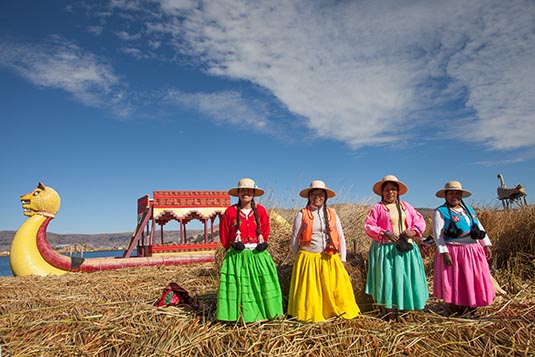 Puno is located on the edge of Lake Titicaca, the world's highest commercially navigable lake - 3860 metres above sea level, on the Peruvian Altiplano. Inca tradition has it that Manco Capac, the first Inca, rose from the waters of Lake Titicaca, under the orders of the Sun God, to start the Inca Empire, which would be centred in the neighbouring region and city of Cusco. 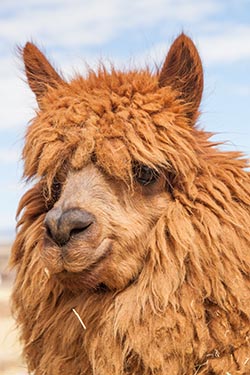 At 8 AM the next morning, we boarded the world-famous Andean Explorer train. This spectacular rail journey begins in historic Cusco and travels south to the beautiful city of Puno, on the shores of Lake Titicaca. On the journey, the train makes a gentle climb to higher, and cooler, altitudes. The first half of the journey is dominated by the magnificent Andean mountains which towers over the deep valleys of the meandering Huatanay River. It then reaches the gentler, rolling Andean Plains, where vicuna and alpaca can be seen. The glass-walled observation car provides the perfect opportunity to view the beautiful scenery. It's a beautiful 10-hour journey.
At 8 AM the next morning, we boarded the world-famous Andean Explorer train. This spectacular rail journey begins in historic Cusco and travels south to the beautiful city of Puno, on the shores of Lake Titicaca. On the journey, the train makes a gentle climb to higher, and cooler, altitudes. The first half of the journey is dominated by the magnificent Andean mountains which towers over the deep valleys of the meandering Huatanay River. It then reaches the gentler, rolling Andean Plains, where vicuna and alpaca can be seen. The glass-walled observation car provides the perfect opportunity to view the beautiful scenery. It's a beautiful 10-hour journey.
Enroute this 338-km journey, we cross many villages and towns. The railway tracks are good location for the locals to transact business. When they see the train approaching, they make way. Yes, the train slows down considerably. Out here, the right of way is not for the train, but the locals. 210 Km from Puno and at 4321 meters above sea level is La Raya, the highest point on the journey. It's a cold, remote place whose surrounding snow-draped peaks are often shrouded by mist or fine rain. The train makes a brief stop at La Raya station... adjacent to which is a beautiful church and a market where local craftsmen sell their wares... essentially souvenirs and colourful hand woven items. 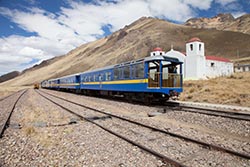 There's entertainment on board. These artists and musicians also double up as models that do a little 'fashion show' to demonstrate the locally made garments. They are for sale. A delicious 3-course lunch is included on the journey.
There's entertainment on board. These artists and musicians also double up as models that do a little 'fashion show' to demonstrate the locally made garments. They are for sale. A delicious 3-course lunch is included on the journey.
At 6 PM we were at Puno station. A bus and the tour guide were waiting for us to take us to Libertador Lago Titicaca - our hotel for the next two nights. This hotel is actually on an island and has its own private jetty. The rooms open up to the lake offering excellent views. The sunrise as seen from the room was amazing indeed. That evening, one of my group member, Nitin Nyati had his birthday. He hosted a lovely dinner for us at the hotel. 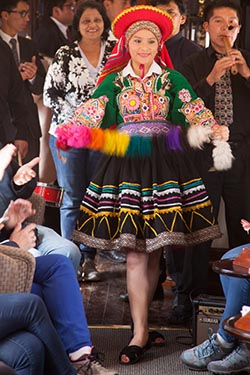 The next day we would explore Lake Titicaca in a chartered boat.
The next day we would explore Lake Titicaca in a chartered boat.
At 9 AM, post breakfast, we walked across the hotel to the jetty. A 20-seater covered motor-boat with a small sun-deck was ready to welcome us. 5 kms. away was our first stop – Uros Islands. The Uros are people who live on forty-two self-fashioned floating islands in Lake Titicaca. They form three main groups: Uru-Chipayas, Uru-Muratos and the Uru-Iruitos. The Uros descend from a millennial town that, according to legends, are ‘pukinas’ who speak Uro or Pukina and believe that they are the owners of the lake and water. The purpose of the island settlements was originally defensive, and if a threat arose they could be moved. The largest island retains a watchtower almost entirely constructed of reeds. The Uros traded with the Aymara tribe on the mainland, intermarrying with them and eventually abandoning the Uro language for that of the Aymara. About 500 years ago they lost their original language. 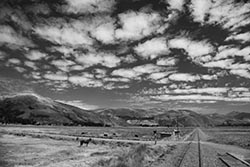 The Uros use bundles of dried totora reeds to make reed boats (balsas mats), and to make the islands themselves. The islets are made of totora reeds, which grow in the lake. The dense roots that the plants develop and interweave form a natural layer called Khili (about one to two meters thick) that support the islands. They are anchored with ropes attached to sticks driven into the bottom of the lake. The reeds at the bottoms of the islands rot away fairly quickly, so new reeds are added to the top constantly, about every three months.
The Uros use bundles of dried totora reeds to make reed boats (balsas mats), and to make the islands themselves. The islets are made of totora reeds, which grow in the lake. The dense roots that the plants develop and interweave form a natural layer called Khili (about one to two meters thick) that support the islands. They are anchored with ropes attached to sticks driven into the bottom of the lake. The reeds at the bottoms of the islands rot away fairly quickly, so new reeds are added to the top constantly, about every three months.
Much of the Uros' diet and medicine also revolve around the same totora reeds used to construct the islands. When a reed is pulled, the white bottom is often eaten for iodine. This prevents goiters. This white part of the reed is called the chullo in Aymara. When in pain, the reed is wrapped around the place in pain to absorb it. Also if it is hot outside, they roll the white part of the reed in their hands and split it open, placing the reed on their forehead. In this stage, it is very cool to the touch. The white part of the reed is also used to help ease alcohol-related hangovers. It is a primary source of food. They also make a reed flower tea. 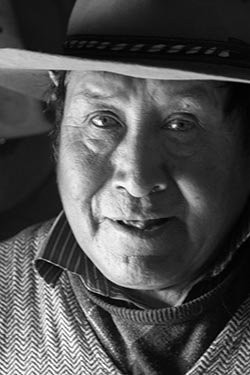 We were welcomed on the Uros Islands by the residents dressed in very colourful attire. Visits from tourists is what they keenly look forward too. Tips and selling their handicrafts is probably the only source of income to those actually living there. Of course, few family members have moved mainland in search of work. It was a totally different feeling, to walk on a 'ground' that sank in by 4 inches every time we took a step. We were quite amazed with the demonstration the locals gave us... the making of the island, their houses, their boats and their handicrafts. Later we hired their reed boat, rowed by a couple, for a joy ride. It was fun indeed.
We were welcomed on the Uros Islands by the residents dressed in very colourful attire. Visits from tourists is what they keenly look forward too. Tips and selling their handicrafts is probably the only source of income to those actually living there. Of course, few family members have moved mainland in search of work. It was a totally different feeling, to walk on a 'ground' that sank in by 4 inches every time we took a step. We were quite amazed with the demonstration the locals gave us... the making of the island, their houses, their boats and their handicrafts. Later we hired their reed boat, rowed by a couple, for a joy ride. It was fun indeed.
As we left their islands, the ladies (to our surprise) waived and sang the famous nursery rhyme "Row, row, row the boat..." Next we moved towards Taquile Islands, about 45 kms. from Puno. Our boat would take about 2 hours to be there. Taquilenos are known for their fine handwoven textiles and clothing, which are regarded as among the highest-quality handicrafts in Peru. Knitting is exclusively performed by males, starting at age eight. Women spin wool and use vegetables and minerals to dye the wool to be used by the community. Women are also the weavers of the Chumpis, the wide belts with woven designs worn by everyone in the community of Taquile. 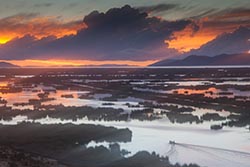 Taquilenos run their society based on community collectivism and on the Inca moral code ama sua, ama llulla, ama qhilla, (Quechua for "do not steal, do not lie, and do not be lazy"). The island is divided into six sectors or suyus for crop rotation purposes. The economy is based on fishing, terraced farming horticulture based on potato cultivation, and tourist-generated income.
Taquilenos run their society based on community collectivism and on the Inca moral code ama sua, ama llulla, ama qhilla, (Quechua for "do not steal, do not lie, and do not be lazy"). The island is divided into six sectors or suyus for crop rotation purposes. The economy is based on fishing, terraced farming horticulture based on potato cultivation, and tourist-generated income.
Taquile's families own rams, sheep, cows, chickens and sometimes guinea pigs. Taquile offers a wide range of typical dishes. Breakfast consists of two pancakes with sugar or bread with eggs, with a cup of tea made from either Muna or Coca. For lunch, dishes are a vegetable soup, fish with rice, and a tomato and onion salad. For dinner, the Taquilean people serve vegetable soup with bread. Our plan was enjoying a lunch in a restaurant, perched next to a cliff, over-looking the Bolivian border. Special vegetarian meals were made for the group. 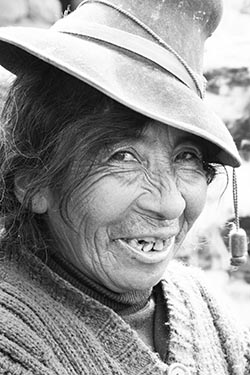 From the pier to the restaurant was a good 30-minute uphill trek. But the effort was well worth it. During lunch, the locals performed their traditional dance and there were demonstrations of weaving and making of shampoo using leaves and herbs.
From the pier to the restaurant was a good 30-minute uphill trek. But the effort was well worth it. During lunch, the locals performed their traditional dance and there were demonstrations of weaving and making of shampoo using leaves and herbs.
On our return trip to Puno, we enjoyed the setting sun. The next morning we would drive to the airport in Juliaca to catch our flight to Lima – the last leg of our South American trip. Enroute airport we visited the Sillustani archaeological site that has a collection of ruined towers built by pre-Inca civilization near Lake Umayo. The towers are chullpas – funeral towers built to commemorate noble men and fitted with offerings to help secure their passage into their next life. These towers are on a hill and you would need to climb up, albeit quite easily. We also made a quick stop to check a local’s house that was walled and gated. The couple was kind enough to show us around… the cooking place, the living quarters and the storage. They even offered us a bite of freshly baked potato. Tied to their main gate were cute little Llamas. Puno Image Gallery  Photo viewer Photo viewer
|
|
|
Home |
Charity |
Feedback
Privacy Policy | Terms of Usage © YoGoYo.com. All rights reserved. |

























































































